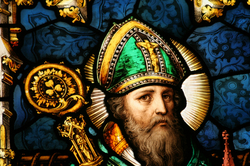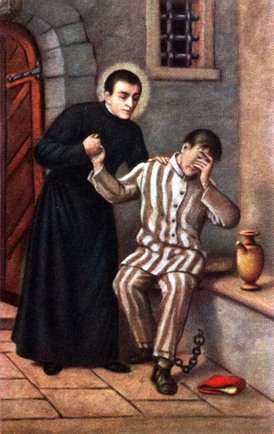The Office of Readings for the feast of Saint Patrick offers a different reading than what is below. In fact, I would urge you to read the Office of Readings for Saint Patrick just so you get to know the real person versus the fiction one hears on his feast, at least around these parts. I am thinking of what it means to live in the awareness of having spiritual patrernity (or spiritual maternity if you are a woman reading this post). We often do not hear much of spiritual fatherhood these days; it is not in vogue in many mainline Catholic centers, unfortunately. But when one considers the fact that we all, because we are baptised into Christ’s death and resurrection, and that we have been given the gifts of mercy, Confirmation and Eucharist, we witness to the Good News of Salvation. By our clear testimony we shepherd others who do not know Christ to know Him. Our very words and actions betry our belief in Christ. The homily of Saint Asterius of Amasea exhorts us to be like Christ the Good Shepherd. Are we up for the challenge on this feast of Saint Patrick? In what ways is your heart like Jesus’ heart? Will you pray for the grace to be a spiritual father or mother to those who need your testimony?
You were made in the image of God. If then you wish to resemble him, follow his example. Since the very name you bear as Christians is a profession of love for men, imitate the love of Christ.
Reflect for a moment on the wealth of his kindness. Before he came as a man to be among men, he sent John the Baptist to preach repentance and lead men to practice it. John himself was preceded by the prophets, who were to teach the people to repent, to return to God and to amend their lives. Then Christ came himself, and with his own lips cried out: Come to me, all you who labour and are overburdened, and I will give you rest. How did he receive those who listened to his call? He readily forgave them their sins; he freed them instantly from all that troubled them. The Word made them holy; the Spirit set his seal on them. The old Adam was buried in the waters of baptism; the new man was reborn to the vigor of grace.
What was the result? Those who had been God’s enemies became his friends, those estranged from him became his sons, those who did not know him came to worship and love him.
Let us then be shepherds like the Lord. We must meditate on the Gospel, and as we see in this mirror the example of zeal and loving kindness, we should become thoroughly schooled in these virtues.
For there, obscurely, in the form of a parable, we see a shepherd who had a hundred sheep. When one of them was separated from the flock and lost its way, that shepherd did not remain with the sheep who kept together at pasture. No, he went off to look for the stray. He crossed many valleys and thickets, he climbed great and towering mountains, he spent much time and labour in wandering through solitary places until at last he found his sheep.
When he found it, he did not chastise it; he did not use rough blows to drive it back, but gently placed it on his own shoulders and carried it back to the flock. He took greater joy in this one sheep, lost and found, than in all the others.
Let us look more closely at the hidden meaning of this parable. The sheep is more than a sheep, the shepherd more than a shepherd. They are examples enshrining holy truths. They teach us that we should not look on men as lost or beyond hope; we should not abandon them when they are in danger or be slow to come to their help. When they turn away from the right path and wander, we must lead them back, and rejoice at their return, welcoming them back into the company of those who lead good and holy lives.


